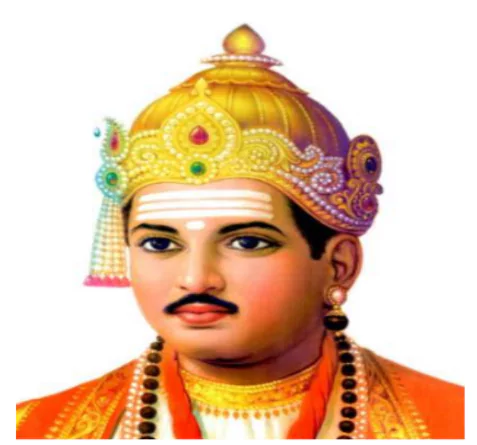Introduction
The Veerashaiva/Lingayat tradition, founded by Basavanna in the 12th century, centers on the exclusive worship of Lord Shiva and rejects idolatry and caste discrimination. It emerged as a response to the oppressive caste system and rituals of medieval Hinduism, promoting equality and devotion to Shiva through distinct practices like wearing the Ishtalinga.
Veerashaivism and the Bhakti Movement: Paths of Devotion and Social Reform
1. Veerashaivism Emergence, and Basava’s Role:
- Founder: Basavanna, a minister for Kalachuri ruler Bijjala II (In the mid-12th century).
- Opposition to Caste System and Rebirth Theory: Opposed the caste system’s traditional customs and questioned the theory of rebirth. [UPSC 2016]
 Support for Social Reform: supported practices like widow remarriage and post-puberty marriage which were disapproved in the Dharmashastras.
Support for Social Reform: supported practices like widow remarriage and post-puberty marriage which were disapproved in the Dharmashastras.- Roots of Veerashaivism: Originating from Shaivism, Veerashaivism is believed to have roots in the worship of Lord Shiva.
- Emergence in Uncertain Times: Uncertainty surrounded Veerashaivism until the 12th century when Basava introduced its distinct ideas and practices.
- Basava’s Influence: Basava’s influence led to the term “Lingayatism,” emphasizing the significance of the Ishtalinga, a phallic image of Shiva worn by followers.
- Essential features: They promoted the exclusive worship of Lord Shiva, rejecting idolatry and the veneration of multiple deities.
- Worship Shiva: as a linga, men usually wear a small linga in a silver case on a loop strung over the left shoulder.
- Those who are revered include the Jangama (wandering monks).
- Discouragement of Temple Visits: They discouraged temple visits, especially those with installed Lingas, and participation in sacrificial rites.
- According to them, pilgrimages to holy places did not ensure true spiritual purity. Donation to temples was seen as fostering inequality.
- Rejection of the “Pancha Sutakas”: Members refrained from adhering to the “Pancha Sutakas”(birth, death, menstruation, spittle, and caste contact), five Pollutions integral to Brahmanical Hinduism’s beliefs and practices.
- Shasthala, Ashtavaranas, and Panchacharas:
- Shatsthala outlined six stages to unite with Lord Shiva.
- Astavarana shielded individuals from spiritual obstacles.
- Panchachara consisted of five religious postures essential for Veerashaivites to safeguard their faith.
- Kayaka: Under this, they emphasized equality in all work and valued dedication. They believed salvation comes through devotion to one’s occupation.
- Transmission of Lingayat Tradition: The Lingayat tradition is known through ‘Vachanas’ (Verses of a devotional nature) in Kannada, composed by both male and female followers.
- Burial Practices and Beliefs: Bury their dead, believing they’ll unite with Shiva after death and won’t reincarnate.
- They do not practice funerary rites such as cremation, as prescribed in the Dharmashastras.
Enroll now for UPSC Online Course
Key Points on Bhakti Movement and Veerashaivism:
- Emergence of the Bhakti Movement: The Bhakti movement gained prominence, offering a spiritual platform for people from diverse socio-economic backgrounds.
- Main Features of the Bhakti Movement: Main features included personal devotion to God, emphasis on rituals, monotheism, and a sense of brotherhood and equality.
- Bhakti Movement as a Unifying Force: It acted as a unifying force for Hindus and non-Hindus, bridging gaps between elites and masses across various levels.
- Veerashaivism’s Similarities with the Bhakti Movement: Veerashaivism, similar to the Bhakti movement, focused on devotion to one God, Shiva, and stressed ritualism.
- Promotion of Equality in Both Movements: Both movements promoted equality among leaders and followers, attracting devotees from various social backgrounds.
- Veerashaivism’s Advocacy for Dignity of Labor and Equality: Veerashaivism advocated dignity of labor and promised equality, signifying significant societal changes in a previously unequal and exploitative system.
Conclusion
The Veerashaiva/Lingayat tradition, with its emphasis on devotion to Lord Shiva and rejection of caste discrimination, stands as a testament to Basavanna’s vision of social reform and spiritual equality. By promoting dignity of labor and rejecting traditional customs, it ushered in significant societal changes, paving the way for a more inclusive and egalitarian society.
![]() May 15, 2024
May 15, 2024
![]() 8553
8553
![]() 0
0
 Support for Social Reform: supported practices like widow remarriage and post-puberty marriage which were disapproved in the Dharmashastras.
Support for Social Reform: supported practices like widow remarriage and post-puberty marriage which were disapproved in the Dharmashastras.